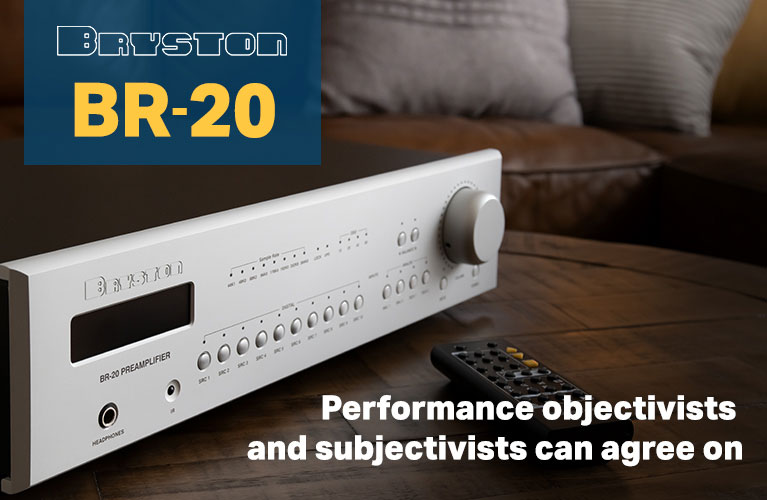This is the article that almost never happened. The idea for it first came up when I was picking up the JBL L75ms Integrated Music System ($1500, all prices in USD) from Gordon Brockhouse’s place. Gordon had just finished reviewing it for SoundStage! Simplifi, and his endorsement of this all-in-one system in that review was so glowing that our team basically had to give it our Reviewers’ Choice award. His praise also piqued my interest. So as I was bundling it into my SUV with the plan of returning it in a few weeks’ time to JBL’s Canadian distributor, Erikson Consumer, I told him that I was tempted to listen to it myself. But that’s when he said, “I have to warn you, it’s really hard to get in and out of the box.”
At that moment, my interest vanished because I can’t stand unpacking and repacking gear, particularly if there’s no good reason for it. But my interest resurfaced while I was listening to the 17th episode of the SoundStage! Audiophile Podcast. Brent Butterworth and Dennis Burger were going on about how interesting Gordon’s review of the L75ms was and how much they wanted to hear it. At that point, I felt a little guilty that the unit was just sitting around in the back of my SUV because I hadn’t gotten it back to Erikson Consumer yet. That prompted me to email Enzo Morelli, who’s in charge of the hi-fi division at Erikson, to ask if I could hold on to it a bit longer to listen to it. He responded that he was “thrilled” to let me do so because it’s a product that, according to him, “no one knows exists.” At that point, I figured I’d better follow through.
Description
If it’s true that no one knows the L75ms exists, I’d say part of the blame lies with the creators of JBL’s website. I tried to find the L75ms on jbl.com, but when I accessed the site through the L75ms link I obtained from a Google search, I was automatically redirected to the homepage of the Canadian version of the site because I live in Ottawa, Canada. The problem was that the Canadian version of the site didn’t have a page for the L75ms—and I think it still doesn’t. I emailed Morelli, who told me that he was already aware of the problem and mentioned that the workaround was to scroll to the bottom of the homepage and change the country to United States. From there, you click through various menu options to get to a specialty audio subsite where the L75ms is listed. I finally found it—but honestly, I have no idea why JBL would make it that hard.
Thankfully, unboxing the L75ms wasn’t as hard as Gordon suggested—or anywhere as difficult as finding the product on the JBL website. The L75ms is kind of awkward because of its shape, and it’s pretty big for a speaker of its type. But since I’m used to getting floorstanding speakers out of their boxes, I’d had enough practice that unboxing the L75ms was a breeze.
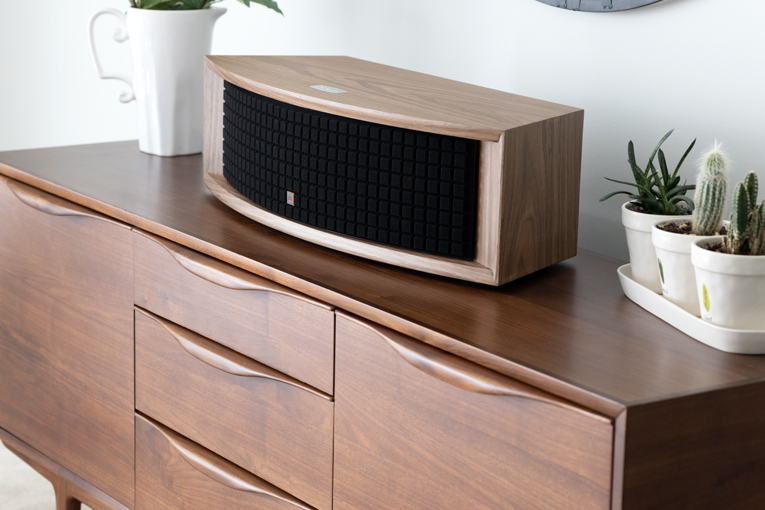
Once out, I took a moment to admire it. The L75ms measures about 31″ × 8.5″ × 11″ at its widest, tallest, and deepest points. Gordon called it “the biggest tabletop music system” he’d ever come across. It’s the biggest one I’ve seen as well. But I’d also say it’s the best-looking one I’ve personally experienced. With its hornlike cabinet shape, attractive wood finish, and very JBL-from-the-1970s-looking foam grille, the L75ms has a distinctly retro vibe while still appealing to modern-day sensibilities.
The L75ms didn’t look too bad when I removed the grille to glance at the driver complement underneath either—though most people are likely to leave the grille on, particularly since it doesn’t detract from the sound. But it’s important to take a look at the drivers at least once to understand exactly why you’re hearing what you’re hearing. As Gordon wrote in his review: “On either side of the front baffle is a 5.25″ pulp-cone woofer powered by an amplifier rated at 125W RMS and a waveguided 1″ aluminum-dome tweeter powered by an amplifier rated at 25W RMS. In the center is a single 4″ pulp-cone midrange driver powered by an amplifier specified to output 50W RMS.” Gordon called it an “unusual driver complement,” an assessment I agree with—mainly because it has that 4″ driver smack in the center.
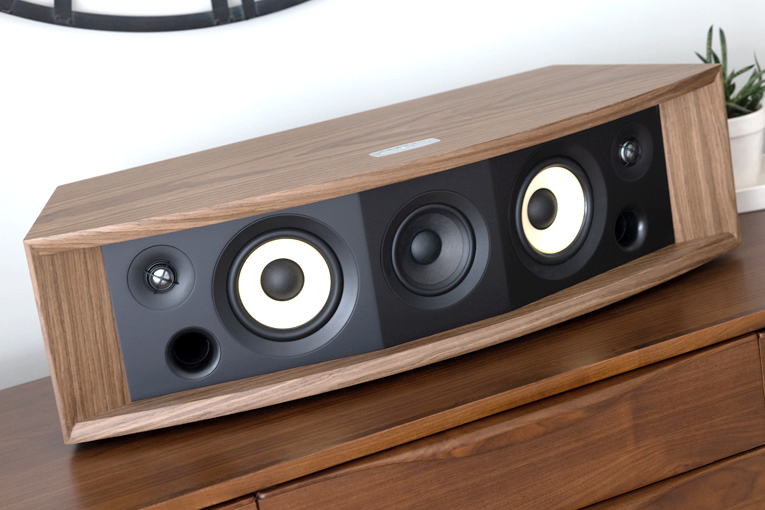
If the 4″ driver weren’t there, the L75ms would be like having two two-way speakers in one relatively large cabinet. But having it there changes the rules. According to Gordon, that driver “receives a summed mono signal, reduced in level and bandpass-filtered between 200Hz and 7kHz. It functions as a center-fill channel, keeping vocals and dialog focused in the center when the JBL’s Soundfield Expander (SFX) feature is engaged.” I’ll discuss the SFX feature more below—because it’s important.
The L75ms’s connection options are good. Wi-Fi and Bluetooth are supported for wireless connectivity. On the heatsinked back-panel plate are an ethernet connector for a wired network connection, a 3.5mm (1/8″) stereo analog connector, one pair of RCA inputs for the onboard moving-magnet phono stage, an HDMI ARC connector for TV hookup, an on/off rocker switch for power, a small power-cord inlet, a USB port labeled Service, an RCA output for a subwoofer connection, a Reset button (which I wound up using, see below), and a Bass Contour switch with two settings, -3dB and 0dB. The Bass Contour was already set on -3dB, which I found peculiar. But I thought Gordon must’ve set it there to diminish the bass for some reason. I left it set that way and turned the L75ms back around.
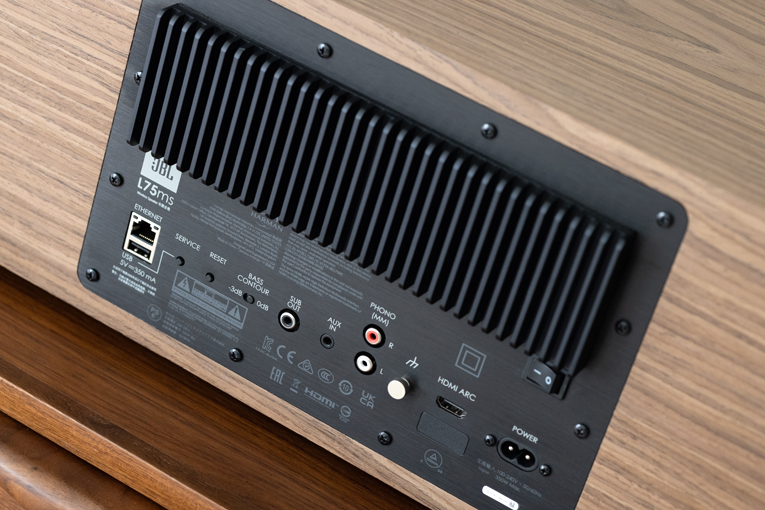
Before I go on, let me tell you why I didn’t use the phono stage, even though I initially thought I might—and some might wonder why I didn’t, since vinyl’s hot these days. The main reason was that when I set the L75ms on the console, my Pro-Ject X1 turntable was to the right of it and my Pro-Ject VC-E record cleaner was to the left. That setup looked like hell, and when my wife walked into the room right after I set the L75ms up there, I saw her wince. So before she could complain and try to convince me to put the L75ms either back in the box or somewhere else, I told her to wait until I moved things around.
I removed the record cleaner from the console, and things looked a little better. Then I removed the turntable from the console, and it was a different world—the L75ms looked fantastic on its own, to both me and my wife. When I wrote Enzo Morelli to tell him that, he replied, “It’s a bit of a prima donna that doesn’t play well with others. It wants aaaaaaaalll of the attention!” He’s right.
The other reason I didn’t connect my turntable was that Gordon had already written about doing that, and he’d done a good enough job. See his review if you’re interested.
Setup
Setting up the L75ms wasn’t hard, which heightens its appeal. Once it was on my living-room console, I plugged it into the wall and watched as lights on its top panel lit up. Then I toggled through input options with the input-selector button labeled “+” until the Bluetooth symbol lit up. After that, I was able to pair the L75ms with my phone without issue. I then opened the Tidal app, cued up an album, and music poured out—all without looking at the manual.
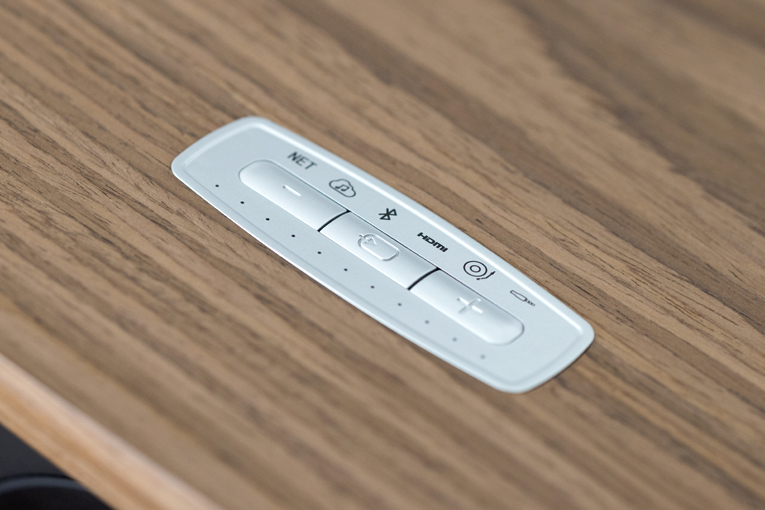
However, the Bluetooth connection wasn’t good enough because, as every self-respecting audiophile knows, Bluetooth is compromised due to its use of lossy compression. Naturally, I wanted to stream losslessly from Tidal, which I figured I should be able to do quite easily because the L75ms supports Google Chromecast Built-in, so all you need to do is install the Google Home app on your phone. My goal was a minimalist setup, so I didn’t even bother with the ethernet port. Besides, Wi-Fi and ethernet are both said to support up to 32-bit/192kHz PCM resolution.
Connecting via Wi-Fi, however, is where I encountered a hiccup. I opened the Google Home app on my smartphone and couldn’t get it to connect to the L75ms properly. I figured that the problem might be that Gordon had already configured the L75ms for his network, so without thinking about it further, I lifted the 35-pound L75ms and turned it around on my console; when I found the Reset button, I held it down until I saw the top-panel lights blinking. At that point, I likely had the factory-default settings back. I opened the Google Home app again and was able to connect the L75ms properly this time. Seconds later, via the Tidal app, I had “Mariners Apartment Complex,” from Lana Del Rey’s Norman Fucking Rockwell! (16-bit/44.1kHz FLAC, Interscope Records / Tidal), spilling out into my room without having to connect any wires other than the power cord that went from the L75ms to the wall plug.
Listening
With “Mariners Apartment Complex” playing and sounding really good, I then tried two things. First, I reached around back and slid the Bass Contour switch to 0dB and heard a subtle increase in bass output, both in terms of depth and volume level. As far as depth goes, JBL rates the extension to 46Hz (-6dB), which might be a touch optimistic, but it’s in the ballpark—the L75ms goes reasonably deep in the bass. I liked that better. But the upper bass was now too present, resulting in a bit of a resonant sound that I didn’t like and making the midrange less clear. I then experimented with other songs and found that some sounded better at the 0dB setting than at the -3dB setting, and vice versa. It was really program dependent, so I got in the habit of simply switching between the two settings depending on what I was listening to.
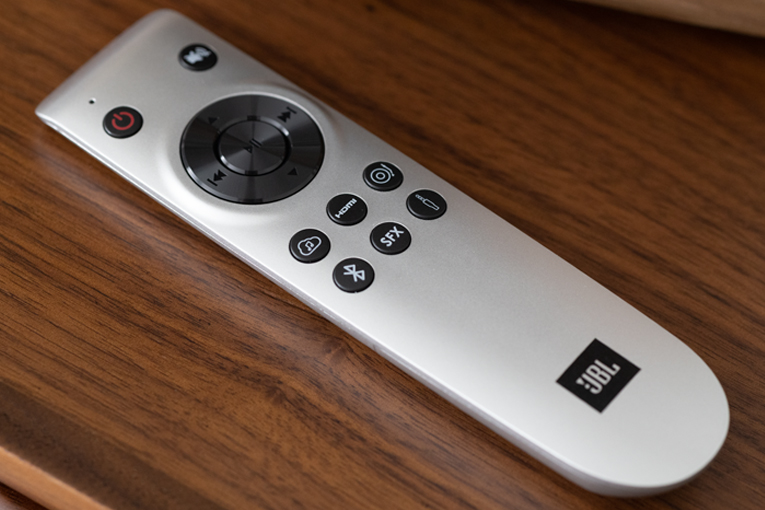
The second thing I did was test the efficacy of the SFX feature, which was also easy because you can just press the SFX button on the supplied remote control (which also controls basic functions like volume and input selection) to engage or disengage the feature as music is playing. Gordon found that the SFX feature “dramatically broadens the soundstage thrown by this one-piece player”; I wholeheartedly agree with this observation. For example, when playing “Mariners Apartment Complex” with SFX off, the sound seemed to be coming directly from the speaker, with Del Rey’s vocal coming pretty much from the center of the enclosure. The soundstage was basically the width of the speaker. With SFX turned on, Del Rey’s voice sounded like it was coming from just in front of the enclosure, as if it had detached itself from the speaker. In addition, the overall soundstage was much larger and airier, not just when I was standing in front of the L75ms, but even if I was standing well off to either side of it. Gordon wrote that the sound in his room extended “about 3′ beyond the L75ms on either side,” whereas for me, it sometimes went a little beyond that, to about 4′ per side, for a truly spacious sound that belied the L75ms’s modest size. Color me impressed.
I also concur with this statement from Gordon’s review: “it was clear that SFX had no effect other than widening the soundstage; it introduced no artifacts.” All true—turning on the SFX processing didn’t add tonal anomalies or other colorations. It simply made the bubble of sound coming from the speakers substantially wider and a little higher, and freer from the enclosure. As a result, I just left SFX on because there was no downside to this.
Regarding the tonality—like a good pair of neutrally voiced stereo speakers, the L75ms sounded commendably neutral from the highs right on down to the lowest frequencies it was capable of reproducing. But as I said, with the Bass Contour switch at 0dB, there could be a little bit too much upper bass, though this wasn’t a gross coloration—it just kind of plumped-up that region too much with certain music.
But most importantly, the L75ms gets the midrange right in terms of naturalness and clarity—and this is vital. If the midrange isn’t right, the speaker as a whole won’t sound right, even to nonaudiophiles, who are as good as audiophiles at recognizing whether a human voice sounds right. This is because we’ve been hearing human voices all of our lives—and the midrange is where voices live.
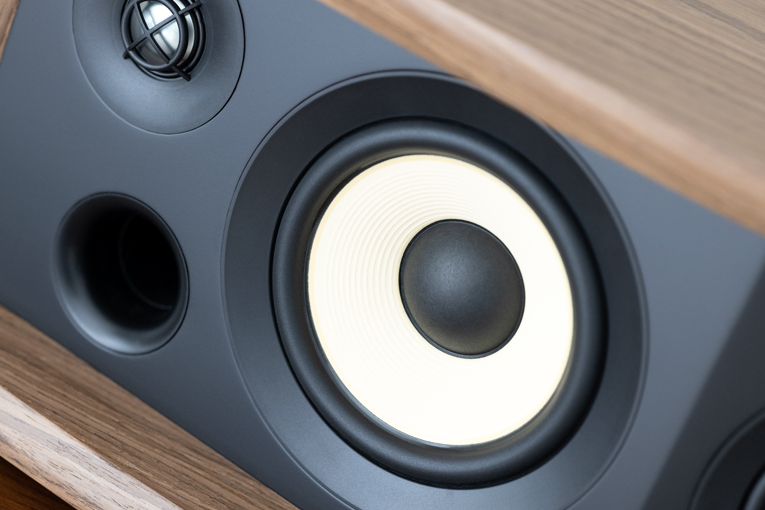
I could hear that the L75ms generated a natural and realistic midrange while I was listening to Del Rey’s vocal on “Mariners Apartment Complex,” and when I played various tracks on Elvis Presley’s Elv1s: 30 #1 Hits (16/44.1 FLAC, RCA / Tidal) and Bruce Springsteen’s Tunnel of Love (16/44.1 FLAC, Columbia / Tidal). But the L75ms’s inherent midrange correctness was absolutely confirmed to me when I listened to the 19th episode of our SoundStage! Audiophile Podcast through it. Dennis and Brent both use good-quality microphones and recording software to capture their voices, and when mixing and mastering they don’t mess with the tonal balance, so their recorded voices typically sound just like they do in real life—and the L75ms reproduced them authentically.
While listening to the episode, I also did an experiment to compare the sounds of their voices when delivered through Wi-Fi and Bluetooth. It was hard to tell the difference with Dennis’s deep, powerful, radio-announcer voice. But with Brent’s voice, it was easy—the Bluetooth feed gave it a little less weight and added a touch of sibilance. That’s not to say it sounded bad or wrong via Bluetooth—it just didn’t sound quite as good.
Not surprisingly, when I listened critically, it was through Tidal via Wi-Fi. Overall, the L75ms did a credible job of providing a full-bodied, natural sound with a tremendous sense of spaciousness—provided the SFX processing was turned on. It sounded good at low volume levels, but what really took me aback was how loud it could play—earsplittingly loud. I later looked at the L75ms’s specification sheet, which indicates that the L75ms can output 106dB at a 1-meter listening distance (though no specific frequency or range of frequencies for that output level is given). Suffice it to say this all-in-one can play loud enough for any small- or medium-sized room.
Bass, too, was impressive enough for the L75ms’s modest size. As I mentioned, it extended to somewhere around 50Hz, which is pretty deep. That’s also what moderately sized standmounted speakers deliver in the same room I was using it in. However, the bass didn’t extend below that at all—and I had to play some really bass-heavy music—like Rihanna’s “Diamonds,” from her album Unapologetic (16/44.1 FLAC, Def Jam Recordings / Tidal), and Dua Lipa’s “New Rules,” from her 2017 self-titled debut (16/44.1 FLAC, Warner Bros. / Tidal)—to feel a sense of bass power and real weight. All in all, expect decent-but-not-awesome bass from the L75ms, even on the 0dB Bass Contour setting.
However, if you’re into bass, you do have the option of adding a subwoofer like Gordon did. He used the outstanding SVS 3000 Micro (which retails for $899.99) with the L75ms and attained much deeper bass. This comes as no surprise—that’s exactly what you add a sub for. But you shouldn’t consider it mandatory to add a sub—I found that the L75ms had enough of a fleshed-out bottom end that the system never sounded too light or thin, even when I played some rather bass-light music. As I said, its bass reach is like a pair of moderately sized standmounted speakers.
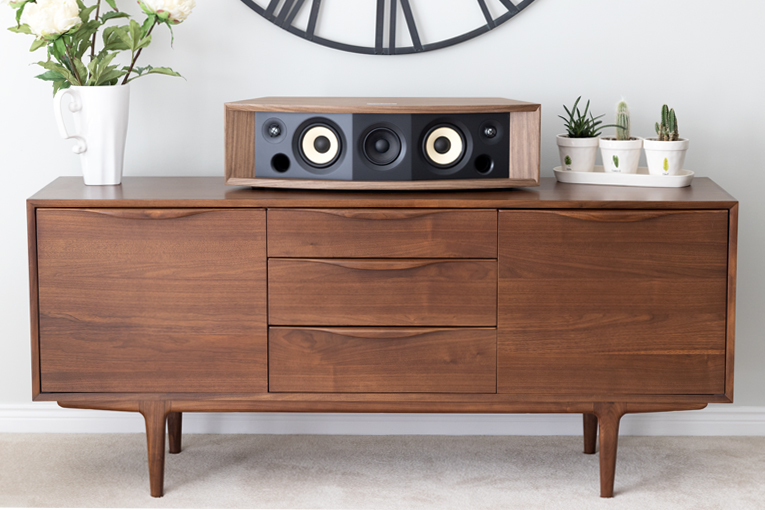
Mind you, that’s not to say the L75ms’s sound is equivalent to having a pair of standmounted speakers. With standmounted speakers, you can place them much wider—8 to 10′ apart is typical, which will create a wider soundstage. Not only will this give you an even more spacious spread of sound, you’ll also get a more credible soundstage presentation with proper imaging, making it much easier to locate where within that space the musical sounds are coming from, left to right and front to back. In contrast, the L75ms—with SFX turned on—gives you a massive bubble of sound for the speaker’s size, with decent center fill and a vague sense of where instruments are placed within the soundstage.
But the L75ms isn’t out to compete with standmounted speakers, and definitely not with floorstanding speakers, even if SFX does really help to spread the sound out. Instead, it provides a credible semblance of a full-fledged stereo speaker system, but in a compact, self-contained package that’s reasonably priced and super-attractive.
Conclusion
I’ve experienced the sound of several all-in-one music systems, but the JBL L75ms is the first of its kind that I’ve written about in this column. It will probably also be the last—at least for the foreseeable future. Yes, you read that right. The reason is that, starting with the next installment of “System One,” I’m going to take this column in an exciting direction. I’ll be focusing on the kind of traditional stereo setups that I don’t think any hi-fi writer has ever written about. All-in-one sound systems like the L75ms simply don’t fit with that direction.
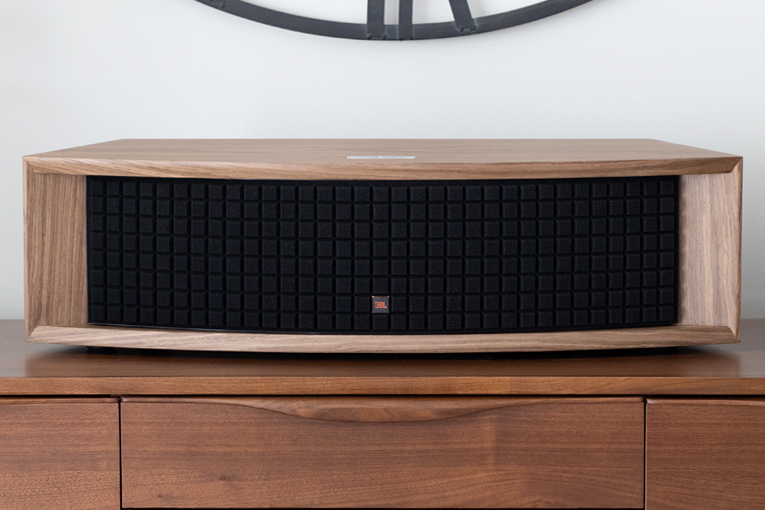
Therefore, I’m happy that I unboxed the L75ms, experienced it, and was able to highlight it in this column before venturing down that path. When it comes to looks and sound and convenience, this all-in-one sound system is killer—and it’s an easy recommendation for someone who’s looking for a high-quality all-in-one music system. No wonder Gordon liked it so much. And with Christmas coming, it would make one helluva gift.
But I want to pass along one warning to prospective buyers: although the L75ms will probably sound good wherever you place it in a room—within reason, of course—if you want it to look its best, you really need to give it a space in your room where it can stand proudly on its own. It deserves that kind of attention. And it definitely deserves to be better known because, at present, the L75ms appears to be JBL’s best-kept sonic secret.
. . . Doug Schneider
das@soundstagenetwork.com






















